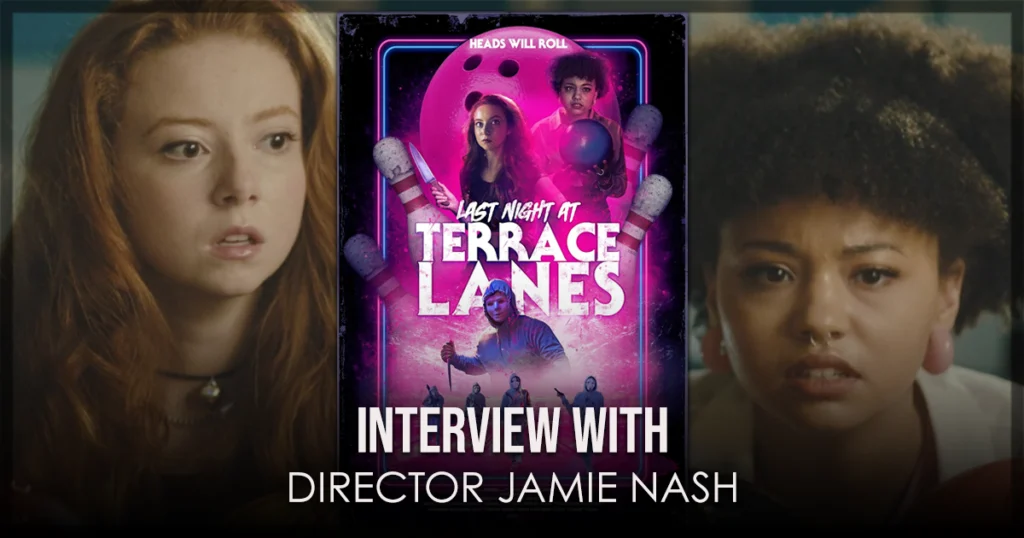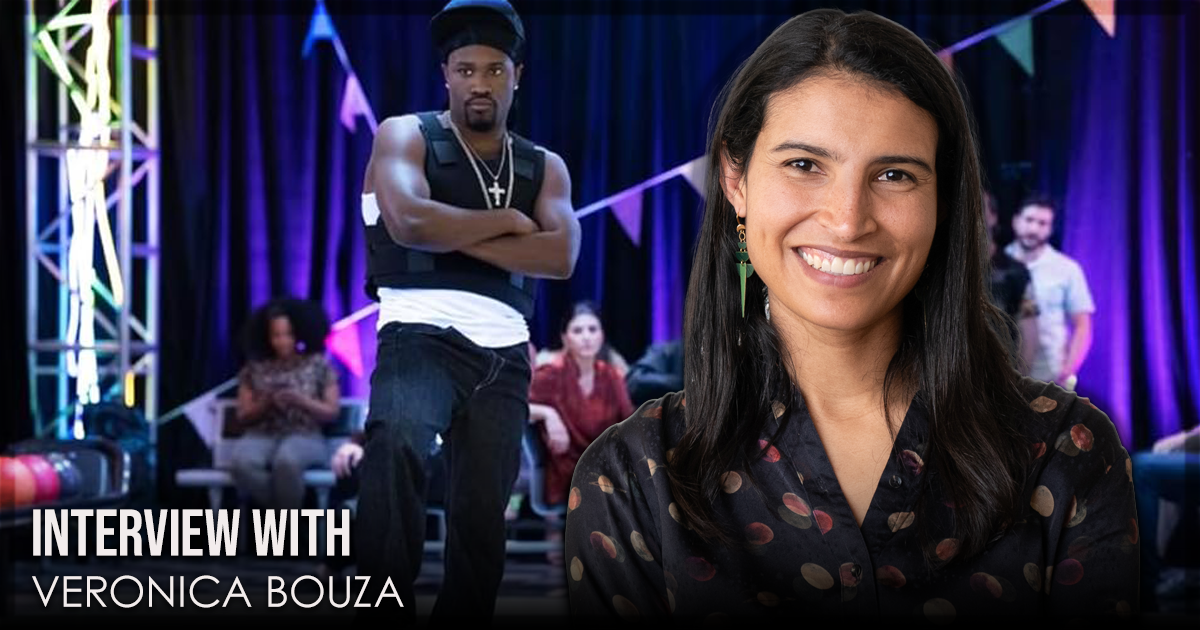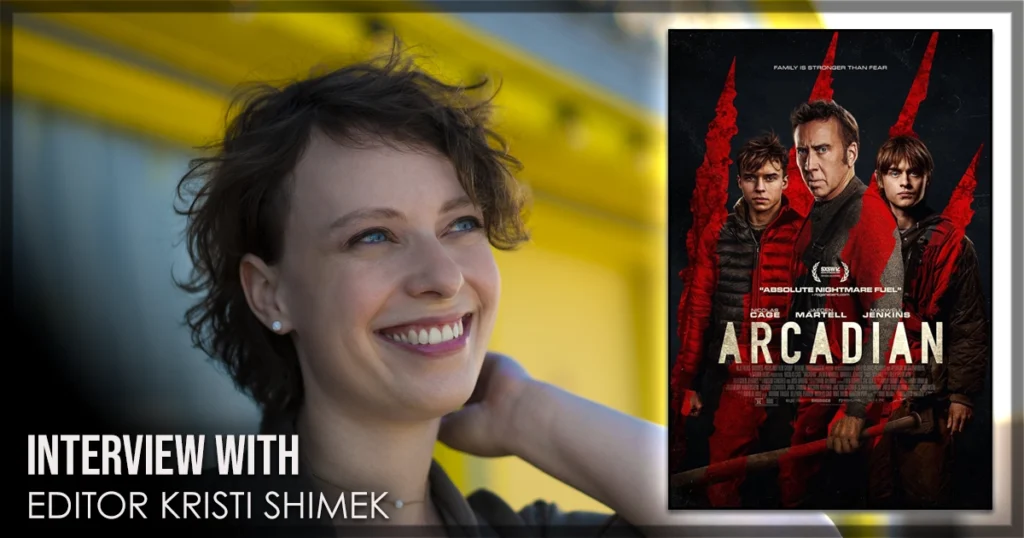The Gutter, a bowling comedy from Yassir Lester (Marvel’s Armor Wars) and Isaiah Lester recently had its world premiere at SXSW in Austin. The film stars Shameik Moore, Susan Sarandon, D’Arcy Carden, Jay Ellis, Jackée Harry, and Paul Reiser, just to name a few. Moore plays Walt, a bartender and shoe de-roacher (exactly what you think) at the AlleyCatz bowling alley. Money problems threaten his job, and Walt is forced to step up and compete on the bowling pro-tour, setting on a pin-laden collision course with Linda “The Crusher” Curson, played by Sarandon. It’s hilarious and reminiscent of Dodgeball, Talladega Nights, and The Big Lebowski. We sat down over Zoom with The Gutter’s cinematographer, Veronica Bouza, to talk about the film.
Bouza is a talented cinematographer who was an electrician and camera assistant before getting her masters in cinematography. In our interview, we talked about bringing the world of competitive bowling to life with The Gutter. She shared all sorts of insight, including how hard it was to film people bowling while not getting hit with the ball. Bouza talked about using lensing for emotional impact, especially with Susan Sarandon’s character, and she spoke about why The Gutter is worth watching and rewatching. You can read the full interview below.
The Interview with The Gutter cinematographer Veronica Bouza
[Editor’s note: This interview has been lightly edited for clarity.]
Ayla Ruby: Hi again! I have a lot of questions about the film, but I’m also interested in you. Every cinematographer has a different path and a different way into the business. Can you talk a little bit about yours?
Veronica Bouza: Sure. So, my name is Veronica, and I grew up in Los Angeles, California, and I ended up studying film at DePaul in Chicago. And I learned what weather was like, and it was nice to have friends that just have a sense of this Midwestern hospitality. And after undergrad, I worked as an electrician, I worked as a camera assistant, eventually kind of moved back to LA, and then I hit that point where I really wanted to shoot and kind of move away from camera assisting, so I ended up going to AFI. I got my master’s in cinematography. And then from there, it’s been the last four years of just shooting nonstop and building momentum as a DP.
On how Veronica Bouza joined The Gutter movie team
Ayla Ruby: Can you talk a little bit about how you came onto The Gutter specifically? Were you a bowling fan before this? How do you do that?
Veronica Bouza: I mean, I would love to say, I was like, “Yep, I was a big bowling fan, and I got the movie.” My agent sent me this script, and we kind of talked about I loved sports and I love comedies, and this movie was kind of the best of both worlds. So, I got the script, I read it, and it’s probably one of the funniest scripts I’ve read. And it’s not just like ha-ha funny, but you’re physically laughing because it’s just so ridiculous throughout. So, super excited to meet the team, and just meeting the guys was just super special because they wanted to shoot it more like a drama, or more like a PTA [Paul Thomas Anderson] movie. So, it’s nice to do something visually a lot of fun, a little darker, a little contrastier, but the actual content is super funny.
Ayla Ruby: It reminds me, just from everything I’ve seen, it kind of gives me Dodgeball vibes.
Veronica Bouza: Yes.
Ayla Ruby: But with bowling balls.
Veronica Bouza: Yes, it’s funny because our references, they range from, obviously, Kingpin and The Big Lebowski, but we did use Dodgeball and Talladega Nights and Boogie Nights. And I think it’s finding that balance of bringing back that 2000-era comedy, while bringing it more into the modern age, and just making it feel real and cinematic.
On the project needs of The Gutter
Ayla Ruby: So, you talked about finding that balance. Can you talk a little bit about specific needs of the project, like technical needs, creative needs, anything on that?
Veronica Bouza: Sure. Yeah. I mean, as for technical needs, I mean, our visual design was to make it feel really grounded and make the world really believable because the script and the story were just so ridiculous. So, with myself and Yassir [Lester] and Isaiah [Lester], we developed our rules for the world visually of how we wanted to tackle this of, let’s treat it like a drama. Let’s shoot it in a very serious manner and let the comedy just unfold.
Veronica Bouza: And then really, from a technical standpoint, was figuring out how to shoot bowling. Because, typically, when you bowl, you walk up to the lane, you bowl and you kind of turn around. So, how do you make that feel a little more dynamic? And we had a lot of bowling scenes compared to Dodgeball. So, it’s like, okay, how do we keep us engaged every time?
Veronica Bouza: And I think we ended up working at one bowling alley, and we just kind of made that our home, and we got rid of all the oil on the lanes, so you can actually walk on the lanes. But when you don’t have oil on the lanes, which is super funny, everyone’s really bad at bowling because it doesn’t guide the ball anymore to go straight. So, we had to figure out techniques of how to shoot it where the ball could roll underneath us. At one point we used steel deck, where we put steel deck on the lanes, and then the actors would bowl underneath us. So, you could be able to dolly forward towards them without, obviously, getting hit.
On merging the story with the cinematography in The Gutter
Ayla Ruby: Yeah, no, I can understand the need not to get hit. So, you mentioned Yassir Lester. Can you talk a little bit about collaborating with him and Isaiah, and the idea of story, and how to merge the story with the cinematography, besides aiming for more drama when you’re shooting it?
Veronica Bouza: For sure. I mean, Yassir and Isaiah are just hilarious. But when it came to story, they were very serious. And I think what we did is, we broke down the character arc for Walt and Skunk, and that’s their dynamic duo. And then, we broke down Linda Curson, which is their third villain. She’s Susan Sarandon’s character in the movie, and she plays this person who’s just amazing at bowling that comes out of retirement and challenges them. So, for each scene, we kind of broke down where Walt is in his journey, are we playing into more playfulness, or are we more playing into subjectivity of trying to figure out how he’s going to conquer the world of bowling?
On using zoom for Susan Sarandon’s character and for emotional impact in the story
Ayla Ruby: Now, I read, I think it was an interview or maybe it was just a summary of the movie, where it talked about how for Susan Sarandon’s character, there was a lot of zoom lensing and a lot of close-ups. Can you talk about if that’s true, and the decision to do that, and how you use lensing otherwise for emotional impact and just kind of through the story?
Veronica Bouza: For sure. Yeah. I mean, a big thing was to create Walt’s world, really, in his subjective. So, we came up with the idea of just shooting him on primes, and that with just being on primes, it was more like pushing in and pulling out.
Veronica Bouza: But as we started to research professional bowling, a lot of times they’re more shot on zoom lenses. It’s a little more stoic, and there’s a more kind of magic that comes to it. So, we thought it’d be really interesting to have Walt on more of what you’re seeing in the 2010s, and the kind of modern-day cinema where you’re shooting more on primes, and then shoot all of Linda on zooms. And it just kind of adds this level of fun to her, where it’s that menacing zooming in or zooming out, and it’s a nice kind of contrast as we see them go against each other.
Ayla Ruby: So, you talked a little bit about your career. You’ve done a bunch of shorts and episodes. Can you talk about scaling up to a feature? Was that kind of what you anticipated? Was that challenging, or is it all kind of the same?
Veronica Bouza: It’s funny, because it kind of is all the same in a way. Because the nice thing compared to a short compared to a feature, is that you get to be with that team longer. You really get to live in those moments, and you get to build a group. Because a lot of times when you’re shooting a short, it could go from a day to maybe five days. Whereas this, we had 22 days, so it was almost like each week was its own adventure. It’s like, all right, we just got to remember what’s going on this week. What challenges, what technical things are we trying this week, and then use the weekend as a way to kind of reset for the following week.
Veronica Bouza: So, the three of us really broke it up week by week as a way to still stay fresh. And it’s one of those things, as you start shooting the movie, you start to know your movie. Where the prep becomes a little easier, and everything kind of just falls into place.
On balancing the technical with the creative in cinematography
Ayla Ruby: How do you balance the technical stuff, the prep, making sure all of that’s set with the artists and artistic stuff with cinematography? How do you balance, I guess, left and right brains, maybe? I don’t know.
Veronica Bouza: No, no, I think that’s a great question. I think, because I spent years as a technician, like I was a camera assistant for almost seven years and I worked as an electrician for three years, so it’s one of those things that comes really natural to me.
Veronica Bouza: And I try to prioritize the more artistic, and making sure we’re telling the story to the best way possible, and then I kind of bring the technical into it. So, I tend to do a lot of homework on my own before even going into a project. Or while we’re in prep, I’ll do my own kind of cheat sheet of, what are the technical things that we’re trying to achieve? And maybe lighting wise, what do we want to accomplish? Compared to story-wise, where does the camera need to be for this moment? Or how are we going to get from this scene to the next scene? Stuff like that.
On keeping a straight face when working on a comedy movie
Ayla Ruby: So, this is a comedy, and you were with the crew for a little bit longer. And maybe this is a little bit silly, but how do you keep a straight face when you’re shooting something that’s so absurd? Or is it-
Veronica Bouza: I’m horrible. And I think this project in particular, I think everyone was breaking. And there’s something so funny watching the actors just play these roles really seriously, because not only is the cinematography really grounded, but all the actors were playing it dead serious.
Veronica Bouza: So, there definitely were a lot of moments where we would crack up, but you kind of have to just remind yourself, all right, reset, and try not to show too much emotion. But, it was a lot of fun being on set, just day in and day out. And surprisingly, there wasn’t a lot of improv, but I guess I forgot certain moments in the script, or when you see Susan read a line, you’re like, “Oh, that’s a lot funnier than when I’ve been reading it.” Stuff like that.
On favorite moments in The Gutter, including filming the championship
Ayla Ruby: Is there anything that sticks out to you that’s a favorite moment or favorite thing to bring to life?
Veronica Bouza: For sure. I would say shooting the championship. So, throughout our film, we’re kind of jumping between bowling alley and bowling alley. And like I said before, we only use one bowling alley. So, myself and the PD, Maggie [Ruder], we had to create different looks for each bowling alley. And at times, the bowling alley was split, so you would have the first few lanes are Texas, for example, and then the other side is Florida. So, it’d be really hard to try not to shoot the next day’s location, because we’re kind of hopscotching, and so forth.
Veronica Bouza: So, once we got to the championship, we were able to do a 360 look, which was just really fun to live in. And when it came to lighting, with each bowling alley, as Walt gets better, and he’s kind of moving through the tournament, the lighting gets a little better. It’s a little cleaner. There’s a lot more, what would you say, product value as he gets to the championship. It’s just a lot more kind of stylized.
Veronica Bouza: So, I think we were able to play a lot more. We actually, we had a little crane, and it was just fun. Finally, it was like all of these bowling sequence that we shot kind of built up to this moment of shooting that championship, because that’s kind of the one sequence where we shot all 10 frames.
On what she wants people to know about the movie The Gutter
Ayla Ruby: Is there anything you want people to know about the film? And can you talk about what you’re working on next? Sometimes people can’t.
Veronica Bouza: It’s hard. I can’t really talk specifically what I’m working on next, but definitely I’m in the process of interviewing for features and so forth. So, there’s a lot more fun coming out, is all I’ll say.
Veronica Bouza: But I’m trying to think of other things I want people to know about this movie. I think it’s a lot of fun, and it’s definitely a movie that you would’ve watched on cable midway through, and then just kind of continued watching. It feels really nostalgic to the 2000s. And it’s a fun kind of rewatch, just because you’re not going to catch every joke the first time around, because you’re more grounding yourself of, what is happening in this story? Who is Walt? Who’s Skunk? Who’s Linda Curson? And I think it’s a really exciting world that I think we all would love to expand on. So, it’s fun and really ridiculous.
Ayla Ruby: Oh, that’s awesome. Well, thank you so much. I love this.
Veronica Bouza: Yes. No, I hope you’re able to check it out, and hopefully there’ll be more news coming out about the film.
Ayla Ruby: Awesome. Well, I’m excited. Thank you.
Veronica Bouza: Thank you.
The Gutter recently played at SXSW.
The film does not have current release date. You can learn more about Veronica Bouza at her website.
You might also like…
‘Arcadian’ Interview with Editor Kristi Shimek

‘Last Night at Terrace Lanes’ – Interview with Director Jamie Nash


